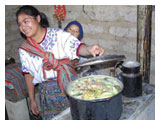The stove was developed by Adrian Padt and Aidan Oosthuysen, and Richard Pocock, and uses a familiar Rocket design surrounded by a wire cage to improve the stove's stability and reduce burns. It's a smart looking stove, it saves women time and energy in gathering firewood, and it has lower emissions than the solutions it is typically replacing.
Lighting instructions:
The Rocket Works Stove, web site http://www.rocketworks.org/
- The Rockt Works stove is a high efficiency wood burning stove, designed to accommodate multiple fuels when required.
- It is smokeless after initial combustion, thereby reducing the likelihood of carbon monoxide poisoning and reducing the emission of black carbon particles.
- The outer cage remains cool to touch even after hours of cooking, due to our innovative design.
- It is made from high quality, heat resistant stainless steel allowing for years of regular use.
- It can boil 5 liters of water in 15 minutes using as little as 250g of wood, which is significantly less than traditional cooking methods.
- Its thermal efficiency is 45%, for the Large Pot High Power, performed by the SeTAR Thermal Efficiency Test.
- Its emissions are the best in its class.
Basic Specification:
- Mass: 2.95Kgs
- Height: 270mm
- Diameter : 240mm
Lighting instructions in English:



